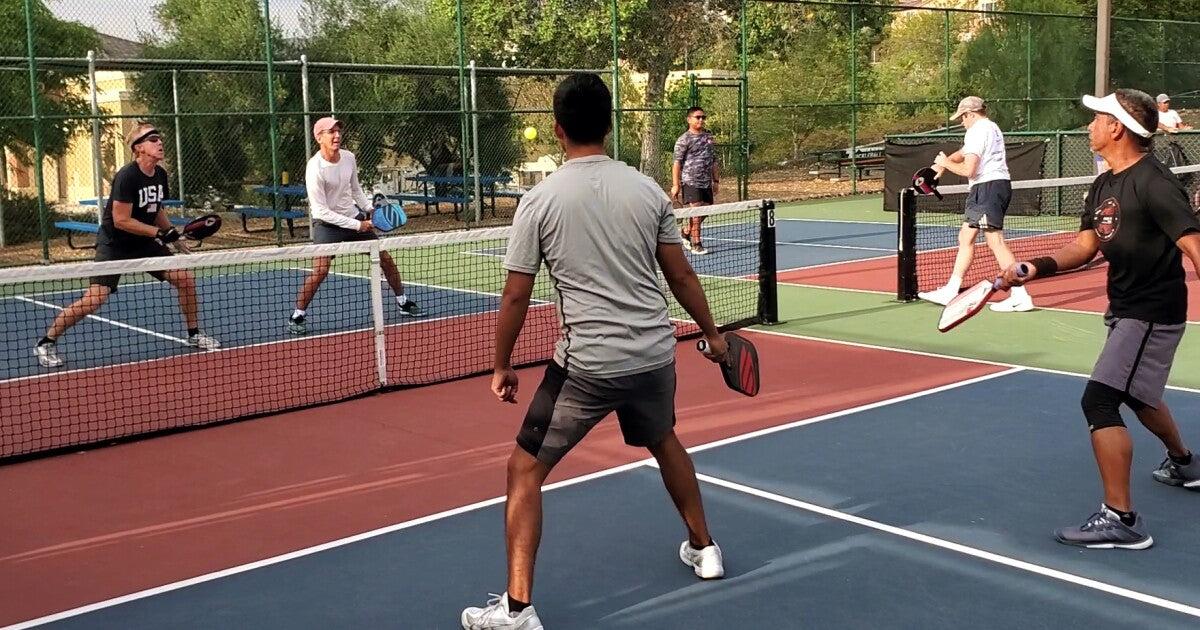Pickleball, a popular racquet sport, has taken the world by storm, captivating players of all ages and skill levels. With its unique blend of tennis, badminton, and ping-pong elements, pickleball offers a fun and engaging experience. In this comprehensive guide, we will explore the origins of pickleball, the rules and techniques of the game, and its evolution over the years.
What is Pickleball?
Pickleball is a paddle sport played on a rectangular court with a net in the middle, much like tennis. It is played with a perforated plastic ball, similar to a wiffle ball, and solid paddles. The game can be played in singles or doubles, making it a versatile and social sport.
Pickleball Origins
Pickleball was invented in the summer of 1965 by Joel Pritchard, a congressman from Washington state, and his friend Bill Bell. They sought to create a fun activity for their families to enjoy during a weekend on Bainbridge Island. The game was named after Pritchard's dog, "Pickles," who would chase after the balls and hide them in the bushes, hence the playful name "pickleball.". Let's be honest, the game would've never got a catchy name if it wasn't for a dog!

The Evolution of Pickleball
From its humble beginnings in a family backyard, pickleball quickly gained popularity among friends and neighbors. As the game spread in popularity, the USAPA (United States of America Pickleball Association) was founded in 1984 to act as a governing body to establish rules, promote the sport, and host tournaments.
How Long Has Pickleball Been Around?
Pickleball has been around for over five decades. Since its creation in 1965, the game has experienced exponential growth in popularity & followers. Initially played by just a few families, pickleball is now enjoyed by millions worldwide. Its simplicity and social nature have contributed to its enduring popularity. Pickleball in all honesty is much like chess. It's easy to get into, but hard to master.
Over the years, pickleball has surged in popularity, attracting players of all ages and backgrounds. Its inclusive nature, social aspects, and the ease of learning have contributed to its widespread appeal. The sport is now played in schools, parks, clubs, and recreational centers worldwide.
What equipment do you need for Pickleball?
To play pickleball, you'll need some basic equipment:
- Paddle: Pickleball paddles come in various materials, including wood, composite, and graphite. Paddle weight can play a big role in performance. Nowadays, high-end paddles are made from premium carbon fiber that make them extremely lightweight and durable.
- Ball: The ball used in pickleball is a plastic wiffle ball with holes, designed to reduce its speed and make it easier to control during play. Pickleballs can differ based on whether you play indoor or outdoors. Indoor pickleball have 26 holes while outdoor balls have 40 small holes.
- Court: A pickleball court is rectangular, measuring 20 feet wide and 44 feet long for both singles and doubles play. The net height at the center is 36 inches. While indoor and outdoor courts have the same size, the surface might be different. Indoor courts typically have rubber cushioning while outdoor courts are made with concrete or asphalt.
- Footwear: Players should wear appropriate court shoes that provide traction and support to prevent injuries.
How to Play Pickleball?
Pickleball is easy to learn, making it accessible to beginners while still providing a challenge for more experienced players. The basic rules include:
- Serving: The serving team must serve diagonally to the opposite side of the court. The serve must clear the non-volley zone, known as "the kitchen."
- Scoring: Points are scored only by the serving team, and games are typically played to 11 points, with a two-point advantage required to win.
- The Double Bounce Rule: After the serve, both teams must let the ball bounce once before hitting it. After the initial bounce, players can volley the ball.
Pickleball Tournaments and Competitions:
Pickleball has evolved from a casual backyard game to a competitive sport with regional, national, and international tournaments. The USAPA hosts various events, including the USAPA National Pickleball Championships, which draw top players from around the globe.
Pickleball and Physical Health:
Apart from being fun, pickleball offers numerous health benefits. The game improves hand-eye coordination, balance, and reflexes. It also provides a low-impact workout, making it suitable for individuals of all fitness levels, including seniors.
Pickleball is a highly social sport that fosters camaraderie and community. Whether playing at local courts or participating in tournaments, players often form lasting friendships and support networks through their shared love for the game.
Conclusion:
Pickleball, with its fascinating origins, simple rules, and inclusive nature, has become a beloved sport that continues to captivate players worldwide. From its creation in a backyard to international tournaments, pickleball's journey is a testament to the power of innovation and the joy of play. As it continues to grow in popularity, the legacy of pickleball as a game of fun, skill, and friendship remains unwavering.

